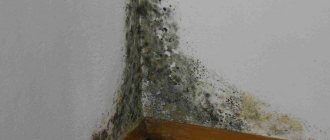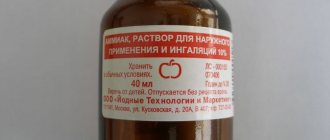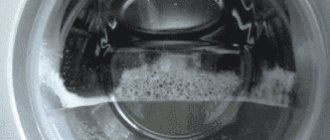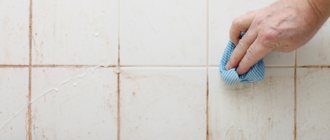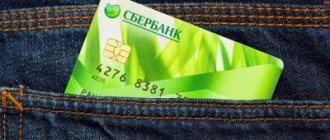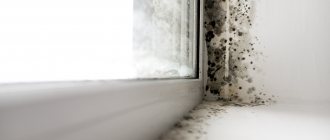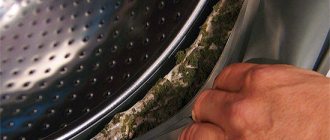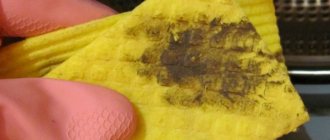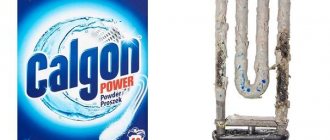Cleaning off mold on the rubber band of a washing machine is not as easy as it seems: conventional cleaning products cannot cope with fungal deposits. But don’t rush to the store for expensive sprays and “special purpose” liquids, because you can make them at home, spending 10 or even 20 times less money.
Professional and folk remedies for cleaning rubber bands in the washing machine
The doors of front-loading washing machines are equipped with rubber bands. The part serves as a reliable seal and seals the drum, which is filled with water during washing.
Like all other parts of the automatic machine, the rubber seal requires periodic maintenance. You will learn how to properly treat the protective cuff and extend its service life here.
Lemon acid
This is another budget-friendly product that will help deal with mold on the rubber band of your washing machine. I think every housewife has citric acid in her kitchen. You will also need any cleaning agent. I use Domestos. It is inexpensive and effective.
First you need to prepare your work surface. Wipe the elastic band thoroughly with a simple damp cloth. You can use a simple dishwashing sponge soaked in a mild soap solution. Try to remove all debris and dirt accumulated in the seal.
Next, apply Domestos or another household appliance cleaner to the rubber band. Take a damp cloth, dip it in the powder, and then go over the seal. Try to wipe all hard-to-reach places, otherwise the mold will return again.
Close the washing machine door tightly and leave for at least 2 hours. After this time, turn on the “Rinse” mode without removing the powder from the gum. Before turning on the washing machine, pour half a glass of citric acid into it. The temperature should be at its maximum. It is recommended to do this manipulation twice.
Why do you need to clean?
The rubber seal has a complex design with bends and folds. Dirt, hair, lint and debris accumulate in large quantities in the folds of the cuff - everything that was not removed through the filter and drain hose.
Due to the configuration, the rubber constantly maintains high humidity , which serves as an excellent environment for mold.
Attention! The remains of garbage are subject to rotting and mold infection, unpleasant odors and black spots appear - colonies of fungi and bacteria.
The musty smell not only creates an unfavorable atmosphere in the room, but also permeates washed clothes. Therefore, a responsible housewife should not have any questions about why the rubber band needs to be cleaned.
Causes of unpleasant odor and fungus
The unpleasant odor of the seal appears for the same reasons as in the drum of the unit:
- Incorrect installation of the device - if the machine is placed on the floor at an angle, the water does not completely drain out of the pipes.
- Abuse of low-temperature washing mode - the insides of the machine cannot be disinfected with hot water.
- Inadequate care of parts and detergent container.
- Refusal to use anti-scale agents and powders with bleaching properties.
- If the device door is constantly closed, the drum and rubber band do not have time to dry out, but remain wet.
- Storing dirty laundry in a “washing machine”, where bacteria multiply intensively and a stench appears.
- Lack of preventive cleaning of the washing machine - inside and outside the body.
- Incorrect use of rinse aid - it must be washed off with a double rinse, otherwise an oily residue remains, ideal for fungus.
Important! Poor water quality is one of the causes of odor and mold. It is recommended to use water softeners that will fight limescale on the gum.
Cleaning the washing machine from mold using household chemicals
It is well known that chlorine is the best remedy in the fight against fungus, and therefore, when mold stains appear, any cleaning agent that contains it should be applied to them (information about this must be indicated on the label). The applied product should be left for a couple of hours and then rinsed off. There will be no trace left of stains after this procedure.
Choice of product
A variety of household chemicals are suitable for caring for the sealing cuff of an automatic machine. It is important that they not only have bleaching, deodorizing and cleaning properties, but also be able to cope with mold and bacteria.
Baking soda
Use soda to clean the cuff manually - a self-prepared gruel or soap solution will do. In the first case, 2-3 tablespoons of soda are combined with a small amount of water to obtain a paste.
Apply the product to a kitchen sponge and wipe the gum around the entire perimeter, carefully treating the inner surface.
The second option is to mix a spoonful of baking soda with gel or dishwashing liquid . A soap solution works in the same way - apply to dirt and scrub thoroughly. You need to let the soda act for a while (about half an hour), and then rinse off the remaining substance with clean water.
Important! During the washing process, it is forbidden to stretch the elastic band too much, otherwise the seal of the automatic machine will be broken.
Antibacterial and chlorine-containing agents
This group of products includes household chemicals containing disinfectant additives to eliminate bacteria, viruses and mold. They do not have to be designed specifically for the washing machine.
Universal products for caring for plumbing fixtures, tiles, and work surfaces in the kitchen are suitable:
- “Toilet duckling”;
- “Domestos”;
- Sanfor;
- Neomid;
- Cillit Bang;
- Mildew remover;
- Veksa;
- Vanish.
Advice! Choose the release form that is convenient for you - spray, gel or liquid. The drug is applied to the gum with a washcloth or a damp cloth, and after 30-60 minutes it is washed off along with the dirt.
Copper sulfate
Copper sulfate pentahydrate is especially popular among summer residents for controlling pests of trees and shrubs. In everyday life, the antiseptic, antifungal and disinfectant properties of the liquid are also useful.
How to wash properly:
- Prepare a cleaning solution - 30 g of substance per 1 liter of clean water.
- Soak a rag or washcloth in the liquid and treat the cuff without missing a centimeter.
- Leave the drug to “work” for about a day.
- After a day, turn the machine on to the quick wash mode.
- At the end of the process, wipe the gum dry and leave the door open so that the surfaces are completely dry.
Reasons for appearance
It doesn’t take much for mold to grow inside a washing machine: any poorly ventilated, warm and humid space instantly becomes an ideal habitat for mold fungus.
Mold appears in the machine if:
- the housewife, for reasons of saving time and electricity, turns on the semi-automatic or automatic machine for quick washing and low temperatures;
- uses conditioners and powders in large quantities. In this case, their excess settles on the surfaces of the container and drum;
- does not remove laundry from the drum immediately after completing the washing process;
- rarely descales parts;
- does not wipe the cuff around the door and the container for powder and conditioner from moisture after washing;
- does not clean the filter from contaminants according to the schedule every 2-3 months;
- does not completely drain water from the washing machine due to improper arrangement of the dirty water drainage system.
Mold in the washing machine tray
All these points are a direct answer to the question of why mold appeared in the machine. But if you really have to face it, you need to immediately move on to an active fight.
Rules for cleaning the sealing part
Mold is not the only problem that housewives face when caring for the unit. The washing machine may show signs of rust, limescale , dirty spots and an unpleasant odor. We will now tell you how to deal with each of the problems.
How to remove dirt and stains?
Debris and dirt most often accumulate in the internal space - it is necessary to unscrew the cuff and remove all foreign objects. It is most convenient to do this with a gloved hand and a small washcloth or rag, which can easily penetrate into a narrow space.
Then apply any of the chlorine-containing products (“Domestos”, “Utenok”, etc.) to the same washcloth and treat all parts of the rim. Then close the door of the unit so that the drug works better. After half an hour, complete the procedure by washing with clean water and wiping dry.
Soda gruel also works well with dirt stains - a soft abrasive helps to scrub away stubborn dirt without the risk of damaging the surface.
Important! In advanced cases, you will have to dismantle (remove) the cuff in order to thoroughly disinfect and remove dirt.
From plaque and rust
Not only plumbing fixtures and faucets suffer from limescale deposits, but also washing machines. You can fight plaque with citric acid - place 2 tablespoons directly into the drum and wash on the longest cycle.
Acid removes deposits not only from the seal, but also from the drum with the heating element.
Anti-lime tablets for dishwashers are also suitable for caring for washing machines . It is enough to place 5-6 tablets in the drum and “scroll” the unit idle at high temperature.
Rust does not form on the rubber itself, but along its perimeter on the metal body of the device. But it is also necessary to fight it, otherwise more extensive cracks and stains will appear.
Acetone or nail polish remover will come to the rescue:
- Use a damp cloth to remove visible dirt and rust particles.
- Apply acetone to a cotton pad or a piece of dry cloth and spot treat problem areas.
- Leave the solution on the surface for approximately an hour.
- Turn on the single rinse mode at a temperature of at least 60 °C.
- After rinsing, wipe the rubber seal dry and leave the device to ventilate.
From an unpleasant odor
Housewives manage to eliminate unwanted aromas and eliminate the cause of their appearance with the help of ordinary “Whiteness”.
Instructions for use:
- Pour 1 liter of bleach into the container under the powder.
- Turn on the machine, having previously selected high temperature mode and double rinse.
- Half an hour after the start of washing, the machine is paused for 2-3 hours.
- The unit is started again, and at the moment the rinsing begins, 2 cups of 9% vinegar are poured into the powder tray.
- When the machine finishes washing, wipe the cuff dry and leave the door open.
Substances with intense aroma and disinfectant properties will help get rid of the smell. The rubber band can be wiped:
- natural lemon juice;
- eucalyptus essential oil;
- rosemary, pine or basil oil.
Advice! Another effective option is to pour a couple of tablespoons of lemon juice into the container under the detergents and start the rinse mode at a temperature of 40 degrees.
If it turns black
Method No. 1. Regular table vinegar will help fight mold and at the same time clean the washing machine parts from plaque and dirt.
How to clean:
- Dilute vinegar with water in proportions of one to one.
- Pour the resulting solution inside the cuff - a couple of measuring cups are enough.
- Select the longest wash cycle at high temperature.
- 10 minutes after the start of washing, pause the unit, and after 2 hours start it again.
- Continue working and finally wipe all the insides with a dry cloth.
Important! This method can be used no more than once every 6 months, since the acid can destroy the rubber parts of the device.
Method No. 2. In case of extensive mold damage to the gum, you will need a solution of peroxide and vinegar. Take pharmacy peroxide with a concentration of 3%, vinegar - table vinegar, 9%.
Instructions:
- Mix vinegar and peroxide in equal proportions and place in a spray bottle.
- Wipe the dirt on the cuff with a damp cloth.
- Spray the solution over the entire rubber band, stopping at the most problematic areas.
- After 10 minutes, go through the dirt again with a washcloth or rag.
- Wash off dirt and remaining solution with a rag soaked in clean water.
Method No. 3. Monarda extract has antibacterial and fungicidal properties - this liquid dietary supplement can be purchased at the pharmacy.
To clean the gum, combine 15 ml of extract with 200 ml of cool distilled water. The solution is poured into a spray bottle and sprayed onto the sealing ring. The product does not require rinsing with clean water.
This is interesting: how to descale a washing machine, read here.
How to remove mold from a washing machine
Before starting the fight against mold, it is necessary to conduct a visual inspection of all components of the machine and find pockets of mold. Inspect the seal, powder compartment, hoses, and drain filter. These areas must be thoroughly cleaned with a brush and available products, after which it is recommended to treat them with a specialized composition to eliminate mold.
Next, we will consider separately the substances that can be used to remove mold from a household electrical appliance.
Lemon acid
Citric acid is one of the most effective budgetary remedies against scale, limescale, and fungal microorganisms.
To clean a standard device, you need to purchase a couple of packets of acid. The acid must be poured into the powder compartment, or directly into the drum and run the program at maximum temperature for the purpose of disinfection.
Citric acid can also be used in conjunction with the aggressive Domestos product. This combination is appropriate for particularly advanced cases. The sequence of actions is as follows:
- First you need to put on gloves and close the windows in the bathroom, if there are any. The liquid is applied to the drum itself and the seal around it.
- After this, the device is closed and left to “sour” for four hours.
- Next, you need to select a rinse and start the device, after pouring three tablespoons of citric acid into it.
- At the end of the rinse, start a wash program at 90˚C, adding 200 grams of acid.
- After completion of work, the automatic machine is wiped and ventilated.
Interesting! Citric acid can also be used in combination with washing powder and a small amount of bleach to remove mold.
Soda
Baking soda is another budget-friendly method for getting rid of mold in electrical appliances. To do this, dilute and mix baking soda with water until you get a paste. Apply the resulting mixture to areas where mold has accumulated and leave for half an hour. Use a soft brush or sponge to rub the resulting substance over the surface, then rinse it with water.
Another recipe option:
- Pour 1 liter of table acetic acid and pour 400 grams of soda into a powder tray.
- The empty machine starts at the highest temperature.
This method is very simple, however, it is not safe, since if the device components are significantly worn out and the proportions are not observed, there is a high risk of breakdown.
Vinegar
To remove fungus from product surfaces using vinegar, you will need 200 milliliters of acetic acid. It must be poured into the powder compartment and the wash must be set at 90˚C. This will eliminate dirt, mold and any resulting mustiness. At the end of work, you need to wipe the machine with a dry, clean cloth and run it in quick wash mode without adding any auxiliary products.
Washing powder
To obtain a cleaning agent, the powder is mixed with water and citric acid. The resulting substance must be treated with moldy areas of the device. The device is left in this state for a day, after which all parts are wiped with a brush, and hard-to-reach areas are cleaned with a toothbrush. Next, the device should be started at the highest temperature.
Dishwashing liquid
Dishwashing gel can also be used in conjunction with citric acid to create a paste-like substance that is applied to areas of mold accumulation for 10-20 minutes. Next, these areas need to be rubbed with a brush and rinsed with water. If the result does not appear the first time, repeat this procedure.
Products containing chlorine
One of the most effective means of combating mold is chlorine. It is best to use plumbing cleaners and bleaches for these purposes. Such solutions are applied liberally to the affected areas, after which the device is left to “soak” for a certain time.
On a note! The minimum period of time is half an hour, but if there is excessive contamination, the product can be left for a couple of hours. After cleaning, rinse off the active substance thoroughly and run the empty machine at the highest temperature.
The use of white is widespread due to its significant chlorine content. The use of whiteness ensures total cleaning of all elements and the tank of the device.
Mold Prevention
What you need to do to prevent mold from appearing:
- Do not leave the machine door closed in standby mode;
- wipe the cuff dry after each wash cycle;
- do not overuse rinse aids;
- carry out periodic preventative washing “idle” with citric acid and bleaching powders;
- use softeners for hard water;
- wash at high temperature at least once a month;
- remove blockages in a timely manner and remove debris accumulating in the cuff;
- check pockets of clothes before putting them into the drum.
You should not forget about cleaning the rubber seal - this is one of the most problematic areas of the washing machine.
A dirty cuff serves as a source of bacteria and fungus, which negatively affect the hygiene of the home and the health of its inhabitants.
Preventive measures
What can you do to prevent mold from ever appearing on your washing machine seal? To do this, you should adhere to a number of preventive standards. These include:
- After each washing process, the washing machine drum should be wiped with a dry cloth. As you know, excessive humidity provokes the formation of mold and mildew, and also shortens the life of household appliances.
- Another ideal condition for the development and spread of mold is wet laundry left in the drum. If it's only in there for a couple of hours, the risk of mold growing on the gum increases. This is why it is so important to immediately remove washed items from the washing machine.
- Never leave water in the powder and bleach compartment. After each washing process, the tray should be removed and wiped dry with a cloth.
- It is very important to monitor the filter of your washing machine. It must be changed at intervals specified in the operating instructions for the equipment. Even the shortest delay increases the likelihood of mold growth.
- Once every 3 months it is recommended to wash with maximum water temperature. Once every six months, vinegar or citric acid should be added to the car, as described above.
The above recommendations will help not only prevent mold on the washing machine seal, but also reduce the likelihood of scale formation.
Useful video
How to quickly and easily clean your washing machine:
The area around the door of a front-loading machine is an ideal breeding ground for germs. Accumulations of dirt, mucus, and foam residues settle on warm, damp rubber, where mold is successfully cultivated within a few days.
From dirt and stains
Black traces of fungus are a consequence of improper care of the washing machine. Gray plaque is easier to remove:
- Use a damp cotton cloth to remove dirt from accessible areas of the seal.
- Protect your hands with household gloves.
- Take out the inner surfaces of the elastic by bending the edges.
- Wash both sides of the cuff with a sponge soaked in Domestos.
- The door is left closed for 20–30 minutes.
- Turn on the drum cleaning mode.
- Wipe the seal dry and ventilate the drum until the next wash in the open state.
From plaque and rust
Rusty stains form along with black stains, growing intensively along the perimeter of the rubber band. Remove plaque with a solvent.
The best way is acetone nail polish remover:
- Ensure hand safety and pay attention to ventilation.
- Mechanically remove the layer of dirt with a napkin.
- The solvent is applied pointwise to the affected areas.
- Leave for an hour.
- Wash using rinse mode at a temperature not lower than 60 degrees.
From an unpleasant odor
The moldy aroma of rotten water will go away along with bacterial contamination.
When you only need to remove an unpleasant odor, use lemon:
- The zest is turned into thin shavings.
- The juice is squeezed out of the pulp.
- Strain from seeds and plant fibers.
- The shavings are placed in a laundry bag.
- Place inside the drum of the machine.
- Lemon juice is applied to the sealing gum, the insides of the drum, 2 tablespoons are poured into the tray.
- Start the rinse mode with a water temperature of 40 degrees.
- Wipe dry, ventilate.
From mold and mildew
Monarda extract will help clean the washing machine seal from germs. The product is sold in liquid form in pharmacy chains as a dietary supplement.
- A bottle of extract will last a long time. 15 ml are diluted in 200 ml of cool distilled water.
- Apply to the areas to be cleaned by spraying.
- No need to rinse off.
The disadvantage of the solution is a specific odor that quickly disappears.
Top 5 chemicals for cleaning rubber parts
If folk remedies do not help, it’s time to turn to special household preparations . Top 5 products will remove mold or mildew quickly, permanently and inexpensively.
HG
A universal product that removes mold, various types of harmful microorganisms, and unpleasant odors. HG is more often used for cleaning tiles, but it is suitable for rubber and silicone products.
Mode of application:
- apply to mold or mildew,
- wait 1-2 hours,
- wash off with a damp sponge.
Price: from 400 rubles.
Tiret
The combination of affordable price and effectiveness makes Tiret a very popular means for cleaning a washing machine from mold or mildew. The cost of 250 ml is only 200 rubles.
Mode of application:
- moisten the sponge in Tiret and wipe the infected area several times,
- leave for 30-40 minutes,
- rinse with clean water.
Blanidas
Blanidas belongs to the category of professional chemistry. Like HG, it is most often used to clean tiles and tiles, but can also be applied to rubber seals. Price: 400 rubles .
Mode of application:
- soak a sponge in Blanidas and wipe the infected area several times,
- leave for 1-1.5 hours,
- rinse with clean water.
Dr. Beckmann
Good quality product at an affordable price. Cost of Dr. Beckmann is only 300 rubles .
Mode of application:
- fill up the contents of one Dr. package. Beckmann directly into the washing machine drum,
- turn on the “Rinse” mode,
- After finishing work, wipe the inner surface of the drum thoroughly and dry.
Sama
A cheap but high-quality product for removing mold and mildew. In addition to cleansing, it also has a disinfecting effect. Price: 100 rubles .
Mode of application:
- apply to the contaminated surface,
- after 30 minutes, rinse with clean water.
How and with what to clean the rubber seal in the washing machine drum
The seal can be washed using different types of home and professional chemicals.
Before cleaning the rubber band in the drum of the washing machine, you need to empty the standard or top-loading machine from the laundry, put on gloves and inspect the unit. The cause of contamination may be mold, scale, rust, or limescale. Black mucous stains are accompanied by an unpleasant odor; it is not always possible to remove stains with homemade recipes.
From mold
Mold on car rubber can be cleaned using a vitriol solution. For 20 g of cleaning agent for washing appliances, 1 liter of water is used. To prepare the product, you need to take a glass jar, pour hot liquid into it, and add the required amount of powder.
Vitriol should not be diluted in metal or enamel containers.
Clean the entire seal with the prepared solution, leave the washing machine for a day to dry completely, and thoroughly wash the rubber with dishwashing detergent. This method is suitable for units whose seal is slightly dirty. You can completely remove mold from a part by removing the cuff and treating the machine body underneath it.
The washing cuff is attached to the body with snap clips. You need to pull them, remove the rubber, treat it with cleaning powder in a basin of warm water. Clean and wipe the area under the mechanism element. Dry the cuff with a dry cloth or paper towel.
We invite you to familiarize yourself with the High-pressure car wash device
Some machines have a different principle for attaching the cuff. Before dismantling the part, you need to study the instructions for the device in detail.
A good substance to clean rubber washing seals is monarda extract. The drug can be found at the pharmacy. The product is diluted in distilled water (for 15 ml of monarda - 200 ml of liquid), poured into a spray bottle, and applied to the dirt without rinsing.
After using any composition, you will need to run the automatic washing machine for a long program at maximum temperature (95 degrees); after completing the cycle, you need to wipe the drum dry and leave it open.
From scale
Rubber can be descaled using household chemicals or folk recipes.
Store-bought products have one drawback - they spoil the parts. Substances should be used only in extreme cases, following the instructions.
The automatic machine needs to be cleaned with citric acid every four months:
- pour 100 grams of product into the washing powder compartment;
- set the mode to high temperature;
- We start a long washing program without laundry.
The method is good for preventing the formation of scale in the car and slime on rubber.
Vinegar solves the problem of mold and salt deposits. They can be used to clean the seal of the washing unit and remove unpleasant odors:
- pour two glasses of vinegar into the laundry compartment;
- put on a long wash, select the maximum temperature;
- after five minutes you need to pause the mode for an hour;
- unpause the machine and wait for the wash to finish;
- run a short program;
- clean all parts of the washing device with a paper towel or dry cloth;
- leave with the door open until the rubber is completely dry.
Dampness and mold are the consequences of poor washing machine care. It is important to determine the location of the odor. If it is not clear where the smell comes from, you should call a professional to identify the cause.
It is recommended to clean the rubber in the drum using household chemicals containing non-aggressive chlorine. A recipe made from vinegar and citric acid will do.
Sometimes scented washing powders can help get rid of unpleasant odors in your car. This method only masks the problem.
You can clean rubber using dishwasher tablets. 6 pieces are poured into the drum, a long mode is started at maximum temperature, and in the middle of the cycle they pause for three hours. If your machine does not have this function, you can unplug the plug from the socket. After 3 hours, washing is resumed. It is recommended to run an additional rinse mode.
Why does mold appear on the hatch seal?
If after washing the laundry smells damp and dirty gray spots appear on it in places, it means that mold has settled in the machine. A similar problem arises due to high humidity and lack of air exchange, as well as poor hygiene. You are at risk of encountering it if:
- Always run the wash in delicate or fast mode. The water heats up to 30–40°C, which is not enough to kill bacteria and fungal spores - microorganisms settle on the inside of the drum and hatch.
- Use conditioner or other rinse aid every time. The softening components contained in these products are not washed off from plastic, metal and rubber surfaces. They form a slimy coating in which mold actively multiplies.
- Leaving wet clothes inside the washing machine for a long time. Dampness, cold and lack of fresh air are ideal conditions for the growth of fungi, so things should be removed from the drum immediately, or at least 2-3 hours after the end of washing. If you can’t hang the laundry right away, put it in a basin.
- Close the hatch when there is water left inside the drum. High humidity combined with low temperature promotes the accelerated development of mold colonies. The hatch should be left slightly open until the machine is completely dry.
Before you start fighting mold, you need to understand what exactly led to its appearance. After all, if the root cause is not eliminated, fungal plaque will appear again and again.
Clean the car under the rubber
The following solutions will help effectively remove contaminants in hard-to-reach areas of the seal and under the cuff:
- Copper sulfate is diluted at the rate of 50 g per 2 liters of softened water.
- The sealing ring is filled or sprayed with the resulting liquid.
- Lasts for 6–12 hours.
- Rinse and wipe dry.
After taking copper sulfate, mold will not return soon.
For complete cleaning, it is important to know how to clean the filter in a washing machine.
Baking soda
If you don’t have hydrogen peroxide and citric acid at home, then there is another way to get rid of mold on the rubber band of your washing machine - baking soda. To prepare the solution you only need one teaspoon of the ingredient. This amount of baking soda must be diluted in one glass of water at room temperature. Do not make the solution more concentrated, otherwise it will damage the enamel or paint applied to the equipment.
Next, use the resulting liquid to wash off the mold on the rubber band of the washing machine. This can be done using a household rag or dishwashing sponge. After the procedure, the surface of the seal must be wiped with plain water.
Complete washing machine cleaning
Comprehensive measures for cleaning rubber in a washing machine are the most effective. This means that it is most effective to remove dirt not in certain areas, but throughout the entire device:
- Check and wash the filters.
- Dry the hoses.
- Treat internal accessible parts of the structure with antiseptics.
- Run the drum cleaning mode once a month.
Only complete cleanliness guarantees long-term operation of the machine without the need to replace parts, repairs, or unscheduled service diagnostics.
Mildew remover for washing machine
Mold is afraid of high temperatures, so it is very important to clean the machine at maximum washing degrees.
An unpleasant-looking black coating that affected the insides of the first assistant in the household can puzzle any woman for a long time. That is why the question of how to remove mold in a washing machine always comes first. You can get rid of fungus by using products containing acids, chlorine, maximum temperatures and completely drying the device. What does this procedure look like?
- First you need to remove the mold using citric acid, which is applied to a sponge and thoroughly wiped with it over the entire surface of the machine. Be sure to leave the product for a while for it to work, and then carefully rinse off.
- The rubber rim near the door must be treated with an aqueous solution of copper sulfate, which has an excellent ability to destroy harmful microorganisms and fungi. It should be left applied for a day, then rinsed with water.
- When deciding how to remove mold, do not forget that it is afraid of high temperatures. Therefore, it is important to run this washing mode in order to wash the fungus from the machine.
- You can clean the unit with baking soda, which has the necessary abrasiveness and does an excellent job of removing fungus.
- At the end of the treatment, it is important to include a rinse to remove all detergents.
- Remember! It is important to let the car dry thoroughly to prevent the fungus from reoccurring.
What means can be used?
Let’s briefly summarize what products can be used to clean mold from a washing machine:
- chlorine-containing substances: Domestos, Belizna;
- alkaline compounds: soda, alkali;
- acidic substances (not too aggressive): vinegar, citric acid;
- copper sulfate;
- for cleaning the drain hose: sewer cleaning compounds (Tiret, Mole and others);
- auxiliary substances (do not kill mold, so they are used in conjunction with those listed above to clean surfaces): dishwashing detergents, washing powder, etc.
Cleaning products
The reasons for damage to the washing machine seal are hidden in the design features of the machine. High humidity, low-temperature washing, abuse of rinse aids, refusal of bleach, rare use of anti-scale agents lead to the formation of a favorable environment for the growth of fungus, bacteria, and accumulations of limescale.
Professional
At the initial stage of the formation of a musty smell, it is enough to run a full laundry cycle. Concentrated powder with bleach will easily eliminate signs of gum deterioration. If black stains are already noticed on the sealing insert, specialized household cosmetics are suitable for removing contaminants from the affected parts of the machine.
Chlorine-based bleaches are a popular alternative to expensive formulations:
The properties of chlorine to kill the microbial environment will allow you to destroy bacterial plaque, prevent its spread, and prevent relapse.
- Concentrated washing powder, containing bleaching granules, helps neutralize microorganisms. With regular use of phosphate detergents, at a temperature of at least 60 degrees, there is no need for additional disinfection of the drum, seal or tray.
- Manufacturer from Japan “Kaneyo” will ensure getting rid of scale, dirt, rust, and fungus. The series is designed for advanced cases, eliminating traces of damage to internal tubes and hoses; will effectively clean the rubber seal in the idle wash mode.
- Tablets are a compressed, concentrated form of fungal control. Contains chlorine or natural biocomponents of plant origin. Among the list of verified ones are “RENE” , “Faberlic” , “Frau Schmidt” .
- There are specialized powders for cleaning washing machines and dishwashers. The Dutch company “HG” guarantees a high-quality victory over mold spores, prevention of the appearance of mucus, and cleaning of the drum from scale particles, dirt, and microbial environment.
Professionals urge you to use specialized products and not experiment with acids, Whiteness , or Coca-Cola .
Folk
To wash away the remnants of alkaline plaque, which form mucus and create favorable conditions for bacterial growth, an acidic environment is used. Practice-tested methods for eliminating mold, plaque, and dirt are used:
- Vinegar 9% is diluted with cooled boiled water in a ratio of 1:3. This solution is used to wash at idle speed, mechanically clean the rubber in a washing machine, and treat the powder tray.
- Citric acid is poured directly into the compartment instead of powder. For 5 liters of loading, 10 g of crystalline lemon juice is enough. If there is a need to remove yellowness from nylon tulle, the processes are combined.
- Hydrogen peroxide removes fungal colonies. The treatment is carried out without diluting the solution. There is no need to rinse off after application. Use a swab soaked in the product to remove dirt, wipe dry, and apply peroxide again.
- Boric acid in the form of a solution: 10 g of powder per ½ liter of boiled water. The mixture is heated until the precipitate is completely dissolved and cooled. They act in the same way as in the recipe with peroxide.
- Essential oils in high concentrations will negatively affect plastic and rubber. Follow the norm: for 5 liters of liquid no more than 3-4 drops of pure oil. Mix 2 drops of tea tree oil with 2 drops of lemon or rosemary oil. Pour into the rinse aid compartment with neutral liquid soap or baby shampoo. The operation, repeated from wash to wash, serves as a prophylaxis against microorganisms.
Fighting methods
You can get rid of mold in your washing machine using store-bought and homemade products. The former act faster and often more effectively (due to the content of aggressive chemical components). Some folk recipes cannot handle serious damage, but if the scale of the problem is small, start with homemade formulations.
Store-bought household chemicals
Every day the market is replenished with new offers with improved formulas
But can all manufacturers be trusted? In order not to spend large sums of money searching for “that” cleaner, pay attention to the rating of proven and popular products
Table 1. Ready-made chemicals
| Name | View | Manufacturer country | Mode of application | Volume, ml | price, rub. |
| "Domestos Universal" | Gel | USA | Apply to the drum, wipe the cuff with a sponge soaked in the product. Leave for 4 hours. Then turn on the rinse mode, followed by a wash at 90° adding citric acid to the tray | 1 000 | 120 |
| "White" | Liquid | Russia | Pour as much bleach as possible into the compartment (the entire bottle) and run a long wash cycle at high temperature. After 2 hours of work, pause (1.5 hours). Continue washing by adding a liter of vinegar to the rinse aid compartment. | 1 000 | 35 |
| "Deo-anti-mold" | Liquid concentrate | Russia | For 5 liters of water, 0.5–1 liter of concentrate is required (treat heavily affected surfaces without diluting). | 1 000 | 170 |
| Cillit Bang | Foam | Great Britain | Removes black mold in 15 minutes. Spray inside the drum, after a quarter of an hour, wipe with a washcloth, turn on the wash | 750 | 300 |
| Neomid | Antiseptic concentrate with water in a ratio of 1:20. | Russia | Antiseptic helps in advanced cases. Apply to problem areas, rinse after 40 minutes | 500 | 535 |
| Savo | Spray | Czech | Eliminates and prevents the appearance of fungus and mold. The active substance acts for 15–20 minutes, then it is washed off with water | 500 | 160 |
| Astonish Mold Mildew | Aerosol | England | The method of application is similar to the previous one | 750 | 270 |
Advice. Using any store-bought mold remover, after the procedure, wipe the tank with a dry cloth and leave the door open for 2 days so that the machine is well ventilated. Wear gloves when handling chemicals.
Home Recipes
On home economics forums you can find many stories about fighting fungus with folk remedies. But if you do not want to join the ranks of word of mouth participants, use ready-made, and most importantly, proven recipes.
Vinegar
Vinegar helps get rid of fungus in the machine by removing salt deposits. Do not use natural apple and grape compositions that may contain dyes and oils - marks will remain on the machine parts. The best option is 9% table vinegar.
Additionally, pour vinegar into the drum itself
Pour 150 ml into the powder compartment, select the maximum temperature and washing mode. When you start spinning, pause it. To eliminate mold, 30 minutes is enough, for limescale – 1.5 hours. After waiting the required time, unpause and complete the cycle. At the last stage, remove and clean the outlet filter, treat the seals, drum, and powder tray with a vinegar solution (50 ml of concentrate per 1,000 ml of water).
Soda
Soda is relevant in cases where minor manifestations of fungus are involved. Prepare a slurry by adding water, and treat the seal lip, drum surface, and cleaning agent bins with this mixture. As a tool, use a toothbrush (for hard-to-reach parts), thin brushes, and dish sponges.
Keep the composition for half an hour to an hour. Finish the process by adding washing powder (1 tbsp) to the tray and starting the machine. At the end of the wash, pull out and dry the outlet filter, wipe all surfaces dry, and ensure the drum is ventilated.
Lemon acid
A safe remedy in the form of a lemon helps remove mold from your car. The effect will be noticeable if the fungus has affected small areas. More often, acid is used as a preventative cleaning once every 3 months or to eliminate musty odors.
For best results, run the machine twice with lemon juice.
Pour 250 g of lemon into a dry powder container and turn on the longest washing program. In this case, there is no need to pause. After the end of the cycle, repeat all the usual steps of removing the filter, wiping parts, rubber, and drum. Do not close the hatch or door until the machine is completely dry.
Cleaning Rules
To prevent mold from developing in the machine drum and a rotten smell from appearing, you must keep the door ajar. Also, after washing, be sure to rinse the powder tray of any remaining detergent. Wipe it with a dry cloth, and also wipe the connector where this tray is inserted. However, let's return to the drum rubber and tell you how to clean it.
- Use a damp cloth to remove mold and other deposits from the outside of the gum.
- Fold back the edges of the cuff and wipe the inside, where mold usually grows.
- Soak a sponge in bleach or another chlorine-containing product.
- Wipe the inside and outside of the gum with a sponge, as well as the surface of the drum. Particular attention should be paid to the grooves of the cuff, applying more product.
- Close the drum and leave the machine for half an hour.
- After disinfection, you need to run the rinse mode to rinse the drum and rubber band of detergent.
You can effectively clean the cuff from mold with a solution of copper sulfate diluted in a proportion of 30 g per liter of water. It is enough to apply a small amount of solution to the cuff, wait about a day, and then rinse with water and wipe with a dry cloth. You can run the machine in the “Fast 30” mode so that the remaining substance is thoroughly washed out.
You need to wash the elastic band of the cuff and remove excess moisture from it after each wash; if you keep the cuff clean, you won’t have to clean it. Even if mold appears, you will clean it much less often.
If too much mold and debris has accumulated under the cuff, you will have to remove it completely . This is not difficult to do; the whole process is described in the article on how to replace the cuff on a washing machine. This has its advantage, because this way you can completely and more thoroughly rinse the rubber in a basin in a large amount of water, then dry it and install it back. And if it is damaged, then replace it with a new one.
If all else fails
Unfortunately, in reality there are such advanced cases that none of the presented methods helps eliminate mold on the elastic of the washing machine. In such a situation, there is only one effective method - replacing the seal. With this question, it is better to contact a special service department, where qualified craftsmen will get down to business.
If you decide to replace the rubber band on your washing machine yourself and do something incorrectly, this may cause a leak, which will negatively affect the further operation of the equipment.
Mold is an unpleasant sight no matter where it appears. However, few people know that such a fungus can be very dangerous to human health. And if it forms on a washing machine, then this only aggravates the situation. Fortunately, it can be eliminated with the help of ingredients that we often use in everyday life. And if you then adhere to preventive measures, then you can forget about mold forever.
